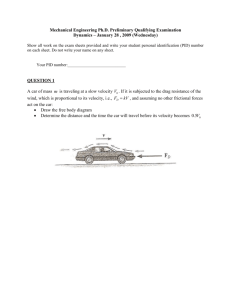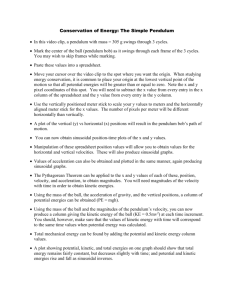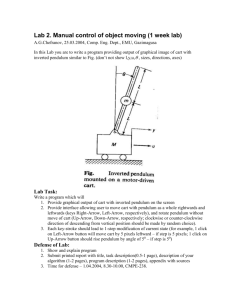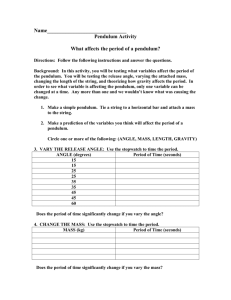Experiment 1-F Ballistic Pendulum and Projectile Motion
advertisement
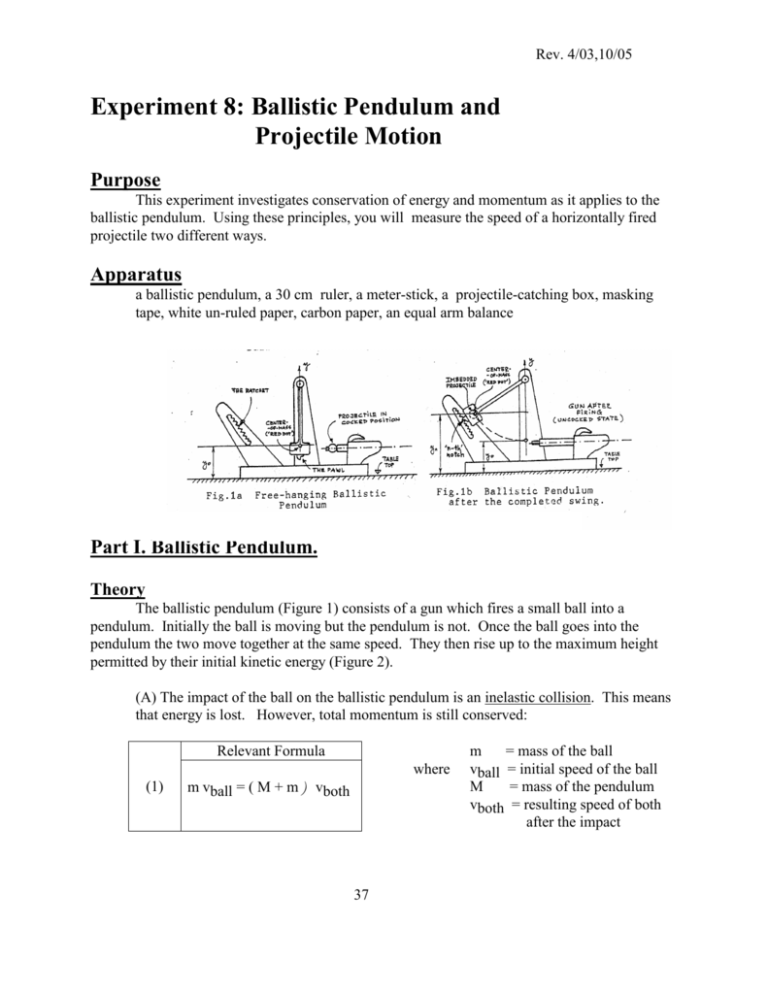
Rev. 4/03,10/05 Experiment 8: Ballistic Pendulum and Projectile Motion Purpose This experiment investigates conservation of energy and momentum as it applies to the ballistic pendulum. Using these principles, you will measure the speed of a horizontally fired projectile two different ways. Apparatus a ballistic pendulum, a 30 cm ruler, a meter-stick, a projectile-catching box, masking tape, white un-ruled paper, carbon paper, an equal arm balance Part I. Ballistic Pendulum. Theory The ballistic pendulum (Figure 1) consists of a gun which fires a small ball into a pendulum. Initially the ball is moving but the pendulum is not. Once the ball goes into the pendulum the two move together at the same speed. They then rise up to the maximum height permitted by their initial kinetic energy (Figure 2). (A) The impact of the ball on the ballistic pendulum is an inelastic collision. This means that energy is lost. However, total momentum is still conserved: Relevant Formula where (1) m vball = ( M + m ) vboth 37 m = mass of the ball vball = initial speed of the ball M = mass of the pendulum vboth = resulting speed of both after the impact Experiment 8 The total initial momentum is simply the mass of the ball times its initial velocity since the pendulum is not moving. After the collision, ball and pendulum are moving together at the same speed and the total momentum is their total mass times their common speed. (B) Energy is conserved during the swing of the pendulum: Relevant Formula (2) ½ ( M + m ) vboth2 = ( M + m) · g · Δ y Δy = the change in height of the center of pendulum + ball measured from any convenient point (for example the apparatus surface) Before the swinging begins, the total energy is the kinetic energy of the ball and pendulum. We choose this position to be the zero point of gravitational potential energy. After the collision, when the ball and pendulum have stopped moving, all the energy is gravitational potential energy. Procedure Part I (a) Detach the pendulum from its yoke. Measure and record the mass M of the pendulum, and the mass m of the ball. Re-attach the pendulum (make sure the screw is tight). On your data sheet, construct Table 1 as shown below. Table 1 y0 = Run # y n(cm) Angle (deg) 1 2 ...etc 38 Experiment 8 (b) Perform a few “trial runs”, as follows: (i) Always make sure that the screw holding the pendulum in its yoke is tight. (ii) Load the gun with the projectile (metal ball) by a steady and careful push until it is cocked. Warning: there are 3 different “cocking positions”. Always use the same one: as a rule, it is the first one (and the easiest) to reach! (iii) Release the trigger gently: never slam on it with your fist! The pendulum will swing and stop when it is caught at a certain notch of the ratchet. (see Fig. 1b). (iv) To liberate the pendulum, unhook the pawl from the ratchet (see Fig. 1). (v) Push out the ball with your finger. (c) Locate the pointer on the pendulum. It marks the center-of-mass of the “pendulum + ball” system. Using the metric ruler measure, with an accuracy of 0.1 centimeter, the height of the pointer above the apparatus surface when the pendulum is hanging freely (as in Fig. 1a). Record this as y0 in Table 1. (d) Make 10 runs, firing the ball (each time from the same cocking position) into the pendulum and record each angle and height yn of the pointer. The angles and heights should be almost the same for every run. If not, alert your instructor. Part II. Projectile Motion. Theory When the pendulum is pushed out of the way, the ball becomes a projectile fired horizontally. Its motion is governed by the following formulas: Relevant Formulae (a) H = ½ g t2 (3) H = initial height of projectile (b) X = vt X = distance traveled in the horizontal direction v = initial velocity in the horizontal direction t = time of travel The motions of a projectile in the horizontal and vertical directions can be considered separately. 39 Experiment 8 The motion in the vertical direction is subject only to the force of gravity and the ball falls from its initial height H an acceleration g until it hits the floor. Since there is no initial velocity in this direction, the ball’s motion is given by formula (3a). Since we know both H and g, we can use this equation to find how long it took to fall t. In the horizontal direction, there is no force or acceleration and the distance traveled X is given by formula (3b). We can measure X and use t from (3a) to find the ball’s initial speed. Procedure Part II (e) Remove the Ballistic Pendulum out-of-the-way by locking it on the ratchet (as in Fig. 1b). Place the projectile in uncocked position, as in Fig.1b. DO NOT PROCEED UNTIL APPROVED BY YOUR INSTRUCTOR. (f) Mark (by a piece of masking tape and pencil) the point P on the floor which is directly below the ball (Fig. 2). Measure the height of the ball from point P on the floor: (1) measure and record the vertical distance hfloor-table from P to the table top (2) measure and record the distance htable-ball from the table-top to the center of the ball Display, on your data sheet, the calculation H = hfloor-table + htable-ball - d where d = 2.0 cm is the correction for the thickness of the projectile catching box (see Fig. 2). 40 Experiment 8 (g) Use masking tape to mark the front edge of your apparatus on the table. It can recoil after a firing, and should be always returned to its original position. Fire a few test runs in order to correctly position your projectile catcher. Take one sheet of white paper covered by one sheet of carbon paper for each partner (shiny black side down). On each white sheet of this stack draw and label a baseline perpendicular to the firing direction, and in front of expected impacts. Secure this stack inside the box with masking tape. Measure and record the distance Xbaseline from P to the baseline (Fig. 2). (h) Fire the projectile five times. The impacts will leave five well-defined dark spots on each sheet in the stack, as in Fig. 3. On your own copy (which is “Data-sheet #2”) label and measure all five values of the distance xi from the baseline to the point of impact. The total horizontal distance traveled is the sum of Xbaseline and xi. Lab Report Show all calculations including units. Part I TABLE for y n Run # yn Deviation in yn 1 2 … AVERAGES Work backwards to find the initial speed of the ball: (1) Construct a table, as shown above, using your data Table I. Calculate the average value y from yn - the average value of yn and y0: y = yn - y0 Use this value in formula (2) to calculate the speed vboth of the pendulum and the ball together after their collision. (2) Knowing vboth and the masses of the ball and pendulum, use formula (1) to calculate the initial speed vball of the projectile. 41 Experiment 8 (3) Calculate (in joules) the kinetic energy of the ball when it was initially fired, and the kinetic energy of the system “pendulum + ball” immediately after the collision. Calculate the percent loss in the total kinetic energy. Part II (4) Calculate the average value x of the five measurements of xi from your Data Sheet #2. Add x to Xbaseline to obtain the average value X which is the average horizontal distance traveled by the ball before it hit the floor: X = x + Xbaseline Question #1: If each value of X were to be calculated as Xbaseline + x and then averaged will the result be more accurate than by the above method? Explain your answer. (5) Solve equations (3a) and (3b) for vball as explained in the Theory section. Use the average X from (4) to obtain the value of vball. (6) Calculate the % discrepancy between the values of vball obtained in (2) and (5). Question #2: Usually, the value of vball from Part II is slightly less than the value of vball from Part 1. What could be a reason for this? 42




